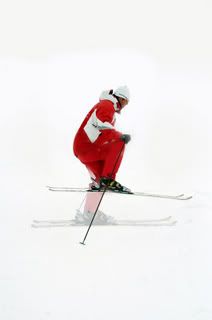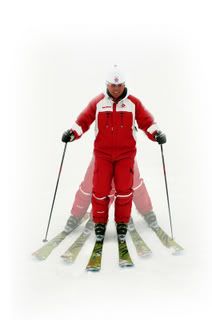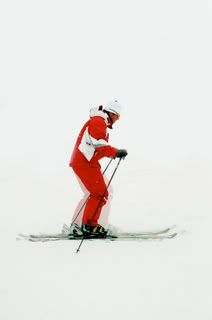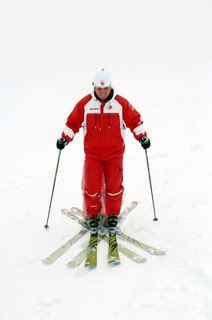So Josh Foster and I have been chatting about skiing, what it feels like, how we approach it, and so on, and he sent me these really great photos along with a sort of distilled version of the CSIA's version of the "core concepts", called "Movement In Motion" Read on, its very interesting!! (And yes, that is Josh in the photos...)

Here's the ski tip that was published to go with the photos. In the CSIA we talk about four planes of balance, vertical, lateral, fore/aft and rotational. Rotational balance is more of an axis than a plane but we lump it in there anyway. The pictures demonstrate lower body movements in all four of these planes. These images all also in line with a concept that we (the CSIA) have called Movement in Motion. This concept describes the relationship between the Centre of Mass (three dimensional balance point of an object, not a fixed point) and the Base of Support (pretty much the feet) in terms of effectively moving downhill. Gravity provides the motion, the skiers contributes movements (in those 4 planes) to deal as effectively as possible with all the stuff happening in a ski turn.

Here's how I look at it, it's a bit out there so see if you can follow it, think of your centre of mass being a basketball and your base of support is a cafeteria tray. Visualize your basketball hovering over the center of your tray. If the tray and the ball were to move down a slope together and they were turning - at any point on the arc if the ball was to drop it should land in the centre of the the tray. This would be accomplished not by manipulating where the ball (COM) is but by positioning the tray (BOS) throughout the turn to support, deflect and capture the COM. Do you see the link between this and the photos?
Here's another way to look at it, balance your ski pole in the palm of your hand with the grip to the top. You won't move the grip to keep it balanced, you'll move your hand. Grip = COM, hand = BOS.
An active BOS and a stable COM is the key to balancing on a pair of skis, you've got to ski with your lower body.
Okay, Kate again: I think that the basket ball/lunch tray is an amazing analogy, because it shows that no matter how the center of mass is moving, it needs to be stabilized, ready to be re-oriented, but still connected to the base. Reading this, I think a lot about what it is like to balance on the
Balance 360 board, how its the tray on top of the ball, but to stay stable, the unit has to move together, in symbiosis.
Thanks for sharing, Josh!
If you have thoughts on this, please post a comment here! (Our skiing community is a bit shy, we've been commenting mostly by email, which is fine, but I'd love for people to get the benefit of all this wisdom!!) (PS, you can post anonymously!)





4 comments:
So, I am guilty of it, too: I just sent this to Josh, and I thought I'd post it here, as well:
While I was skiing in the last weekend, I was thinking of this, and it reminds me of a gyroscopic skiing idea, where all the parts stay related in fluid motion, rather than being broken up into pieces (make an angle, the shoulders do this, the legs do this, don't bend forward) rather, it seems like a total feel you are reaching for, the heavy part of your body staying stable in an effective way over the platform that moves beneath it.
I like the basketball tray analogy. It works in my brain, I'll let you know once I try it out on snow. I have this habit to initiate a turn of throwing my basketball down the hill and then trying to make my lunch tray catch up, maybe thinking of it this way will help me keep my feet with me.
Megan here...CSIA level 3 certified. I am psyched that you are looking outside of the PSIA system to gain more knowledge about skiing. I like the Basketball analogy - it gives another perspective on 'how to stay perpendicular to your base of support'.
Totally! Its funny, when I was at Academy, I took the "International" clinic with the Austrailan, the Canadian, and the New Zeland D team guys (and gals), and it was so interesting to see that we are all really pursuing this common goal, and that there are variations on the thought process, the ideas are broken down differently, but ultimately, its like someone saying the same thing, but in a new way, and suddenly the lightbulb goes on.
Tom used to be my climbing coach, and it was interesting, because he tried to tell me for six months or so, to keep my hips in. He'd tell me to push on my toes, to pull with my feet, to engage my abs, to keep my belly button to the wall...
And I thought I was doing it to some extent. And then, one day, on a super overhanging section, something he said clicked, and I was able to do it while nearly horizontal (I was climbing in a cave feature), and I made the move that had been evading me.
I got back down and I looked at Tom, and without even REALIZING I was doing it, I said, "You know, its a lot easier to do if you keep your hips under you and in toward the wall."
He just looked at me. And then I realized he had been telling me just that for months. But my body hadn't experienced it kinesthetically, or my brain just wasn't getting it.
That's why I love to chat about it so much, with so many different people, you never know where that lightbulb is going to come from!!
Post a Comment